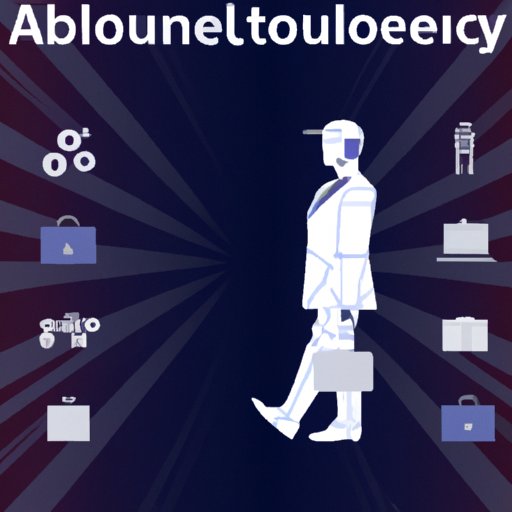Introduction
With the rise of artificial intelligence (AI) technology, many people are concerned about the effects it could have on the labor force and the job market. AI has been adopted by many businesses in recent years, and its capabilities are evolving rapidly. In this article, we will explore the impact that AI has had on employment, the potential for job loss due to automation, and the potential solutions to address the issue.

Examining the Impact of Artificial Intelligence on Employment
AI is defined as “the theory and development of computer systems able to perform tasks that normally require human intelligence, such as visual perception, speech recognition, decision-making, and translation between languages.” AI technology has revolutionized many industries, and it is now being used to automate a variety of tasks that were once done by humans. This has led to a shift in the job market, as more and more jobs are being replaced by AI-powered machines.
Exploring the Job Market in an AI-Driven World
According to a McKinsey Global Institute report, “by 2030, 400 to 800 million workers globally could be displaced by automation, and 75 million to 375 million may need to switch occupational categories entirely.” This means that many of the jobs that currently exist may no longer be available to humans in the future. AI technology is also creating new types of jobs, such as data scientists and machine learning engineers, but these jobs require specialized skills and may not be accessible to everyone.

Understanding the Role AI Plays in Replacing Human Jobs
AI is increasingly being used to automate mundane and repetitive tasks that were previously done by humans. For example, AI can be used to process large amounts of data quickly, which enables companies to make more informed decisions. AI is also being used to automate customer service tasks, such as answering customer inquiries, and to automate manufacturing processes, such as assembly line work. According to an MIT Sloan study, “automation could replace up to 73 million jobs by 2030.”

Analyzing the Effects of Automation on Job Loss
As AI technology continues to advance, there is increasing concern about the potential for job loss due to automation. While some jobs may be replaced by AI, others may be augmented or enhanced by it. For example, AI can be used to assist doctors in diagnosing diseases, or to assist lawyers in legal research. However, it is important to note that the adoption of AI technology does not guarantee job loss, and that the impact of AI on employment will depend on how it is implemented.
Investigating How AI Is Changing the Workforce
AI technology is transforming the way in which work is done. It is enabling companies to become more efficient and productive, and to reduce costs. However, there is also a risk that AI could lead to increased inequality in the workforce, as those with higher levels of education and specialized skills are more likely to benefit from the use of AI technology. There is also a risk that AI could lead to a decrease in wages, as employers may be able to pay lower salaries for jobs that are automated by AI.

Comparing Human and Machine Job Performance
While AI technology is becoming increasingly sophisticated, it is still limited in its capabilities. Machines cannot replicate the creativity, intuition, and empathy of humans, and so for certain types of jobs, such as teaching or nursing, humans are still better suited than machines. According to a PwC study, “automation could replace up to 30% of jobs by 2030, but only 5% of jobs could be fully automated.”
Evaluating the Future of Work with AI
The impact of AI on the job market is complex and multifaceted, and the potential consequences of automation are difficult to predict. While AI has the potential to create new opportunities and increase efficiency, there is also a risk that it could lead to job losses and increased inequality in the workforce. As such, it is important to consider the potential implications of AI on employment, and to develop strategies to ensure that all workers are able to benefit from the advances in AI technology.
The Pros and Cons of AI-Driven Workplaces
AI technology has the potential to increase productivity and reduce costs, but it also carries risks, such as job loss and wage stagnation. It is important to consider both the potential benefits and the potential drawbacks of AI when evaluating its impact on employment. The key is to find a balance between using AI to improve efficiency and ensuring that all workers are able to benefit from the advances in AI technology.
Potential Solutions to Address the Impact of AI on Employment
There are several potential solutions that could help to address the potential impacts of AI on employment. These include providing training and retraining programs for workers whose jobs may be affected by automation, investing in education and skills development, and introducing policies to ensure that all workers are able to benefit from the advances in AI technology. By taking steps to address the potential impacts of AI on employment, governments and businesses can ensure that all workers are able to benefit from the advances in AI technology.
Conclusion
AI technology has the potential to revolutionize the job market and the way in which work is done. While it has the potential to create new opportunities and increase efficiency, there is also a risk that it could lead to job losses and increased inequality in the workforce. It is therefore important to consider the potential implications of AI on employment, and to develop strategies to ensure that all workers are able to benefit from the advances in AI technology.
(Note: Is this article not meeting your expectations? Do you have knowledge or insights to share? Unlock new opportunities and expand your reach by joining our authors team. Click Registration to join us and share your expertise with our readers.)
